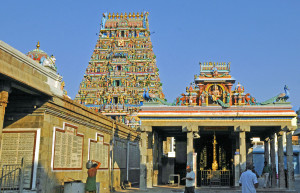In the seventh century, devotees of Shiva, an important Hindu deity, erected a temple along the coast of Mylapore, now a district of Chennai. Called “Kapaleshvara” after an alias of Shiva, the temple remembered an ancient story about Shiva and the peacocks for which Mylapore is named. In the sixteenth century, Portuguese missionaries promoted a story that Thomas, the disciple known for doubting Jesus’ resurrection, had sailed to India in 52 A.D. and was speared to death in Mylapore. Proponents of this historically unsupportable tale claimed to have located the tomb of Thomas under the Kapaleshvara Temple, providing an all-too-convenient excuse for demolishing the temple, which honored beliefs they found offensive, and erecting a church on the site. Today, the stately gothic-style Basilica of St. Thomas, built by the British in 1898 on the original temple/church site, claims to house Thomas’ tomb and the spear that killed him.
Shiva worshippers eventually erected a replacement Kapaleshvara Temple a few blocks inland from its original location. Built in the Dravidian style common in southern India, the imposing temple features a 120-foot-tall gopuram, an entrance pyramid covered with hundreds of colorful effigies of Hindu deities and characters from Hindu stories. Inside the temple, bare-chested priests perform six rituals each day worshiping Shiva, represented symbolically as the lingam, a phallic shape going back to the beginnings of Indian civilization.
Visitors to Chennai’s Kapaleshvara Temple and nearby Basilica of St. Thomas can experience two dramatically different ways of acknowledging the divine. They can also learn how religious intolerants have too often destroyed the worship places of others in plugging their competing beliefs.
